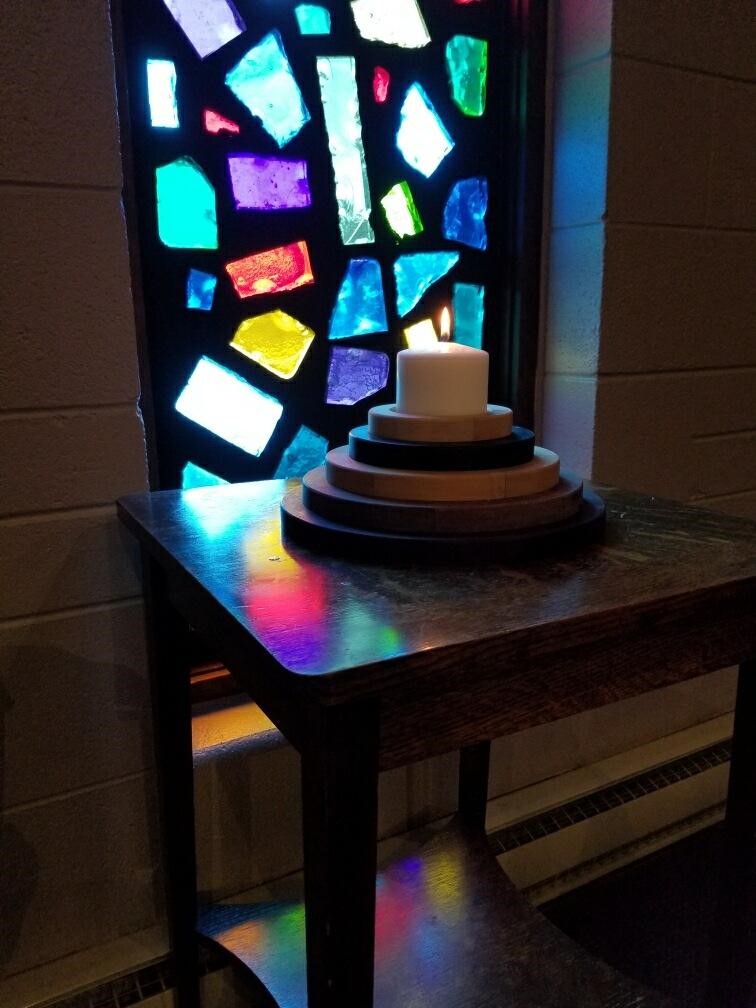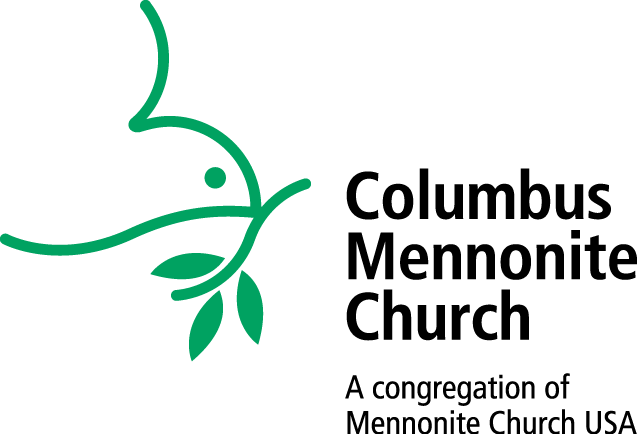
CMC Worship in Place | August 23 | Exodus series
Order of Worship
Prelude
Welcome
Call to Worship
Peace Candle
As we worship in place today, we light a Peace Candle in our home.
May this flame be a sign of our prayer for peace within us, among us, to the ends of the earth.
The flame joins us in spirit across distance, along with our sister church in Armenia, Colombia.
Music Commentary
HWB 366 | God of grace and God of glory | Fred Suter, Marlene Suter, Julie Hart, Phil Hart
Children’s Time
Offering/Dedication Prayer
HWB 164 | When Israel was in Egypt’s land | Phil Hart
Scripture | Exodus 1:8-2:10
Sermon | Things To Do When You Fear God
Silence
HWB 446 | Wade in the water | Steve Rolfe, bass; Tom Blosser, piano;, Alexander Martin, violin, Phil Hart, guitar and vocals
First Fruits Announcement
Sharing of Joys and Concerns
Pastoral Prayer
Extinguishing the Peace Candle
Benediction
Thanks to everyone who led today’s service:
Sermon: Rev. Dr. Jack Sullivan Jr., Ohio Council of Churches
Worship Leader: Julie Hart
Music coordination and commentary: Phil Hart
Children’s Time: Stried Family
Peace Candle: Meaghan Torres
Scripture Reading: Meaghan Torres
First Fruits Announcement: Scott Applegate
…
CMC Worship in Place | August 16 | Parables 7
Sermon Text:
Rock-a-bye baby, on the tree top.
When the wind blows, the cradle will rock.
When the bow breaks, the cradle will fall,
And daddy will catch you, cradle and all.
It feels like several lifetimes ago, but this was one of the bedtime songs I would sing to our girls. If I remember correctly – and the girls have confirmed this memory – I would hold them up in my arms, Rock-a-bye baby on the tree top. Provide some in-house wind: When the wind blows, the cradle will rock. Add some suspense by rocking them, and then letting go: When the bow breaks, the cradle will fall. And offer a peaceful resolution, having just quickly moved my arms down a couple feet, ready to receive what gravity quickly brought into them: And daddy will catch you, cradle and all.
If I also remember correctly, this was a terrible method of calming the girls down for sleep as they would inevitably scream “Again, again” each time.
From a lyrical perspective, you likely notice a change from the traditional lyrics. Not only was the updated version more fun, but it’s less bizarre and, shall we say, less troubling, less violent, than singing When the bow breaks, the cradle will fall, and down will come baby, cradle and all. That image is enough to keep an adult up all night.
Adapting and altering familiar stories, songs, language, is something we do all the time. Consider the older, also more violent, endings to some of our familiar fairy tales, and consider how those fairy tales have been further adapted in movies like Shrek, Into the Woods, and Hoodwinked.
This is what Jesus is up to in his telling of today’s parable.
It begins: “Listen to another parable. There was a landowner who planted a vineyard, put a fence around it, dug a…
CMC Worship in Place | August 9 | Parables 6
Sermon Text:
In Matthew 20 Jesus tells one of those parables that starts out “For the kingdom of heaven is like…” The main characters in this parable are a landowner and laborers. The laborers are hired at different times during the day to work in the landowner’s vineyard. At the end of the day each laborer gets paid the same amount, even though they put in different hours. The message of the parable is summed up at the end: “So the last will be first and the first will be last.”
What first catches my attention about this parable is that all of the laborers are already in last place in the workforce. They aren’t full-time employees of this vineyard owner, but day laborers.
A typical story of a first century day laborer would be something like this: They were former landowners who had been forced into debt by heavy taxation, a poor growing season, or poor health. To get out of debt they would have sold their land to wealthy landowners, now supporting themselves by selling one of their few remaining assets – their labor. Many such laborers moved to urban centers to hire themselves out, a day at a time, to whoever needed their work. Day laborers were vulnerable to abuses and had little control over their day to day work situation. For a day laborer, the regular practice was to gather in the morning at the marketplace, the town square, and wait for someone to come and give them work for the day. If it was harvest or planting season, there was a good chance they would be needed. If it was in between these seasons, labor was in lower demand and they could wait hours or all day without anyone hiring them.
In the parable, the landowner goes out early…
CMC Worship in Place | August 2 | Parables 5
Sermon Text:
The Limit Does Not Exist
When Joel and I were deciding who would preach on which Sundays during this series on the parables, he told me that the parables chosen for the later half of the series each had their own trouble spots and might require a bit of speaking “against the text.” So, since the reading ends at a bit of a cringe-worthy point and that’s probably freshest in your minds, let me start off by saying that it’s important to keep in mind the difference between a parable and an allegory.
Parables are NOT meant to be a word-by-word, character-by-character parallel where each piece of the story directly reveals or represents something else. The King may indeed be meant to represent God, but we do not need to treat every action of the character as if it reveals an undeniable truth about the nature of God.
So while the King gets a little…torture-y at the end of the story, I do not believe we need to assume a direct parallel about Divine torture is meant when Jesus finishes by saying, “So my heavenly Father will also do to every one of you, if you do not forgive your brother or sister from your heart.” I’ll fully admit that might be a pretty weak way to excuse a text that seems to speak about an almighty torturing God, but if nothing else, we also have to consider this last line in light of the rest of the parable and the wider context of Matthew’s gospel.
So where does this parable come from? And what does it reveal about the nature of God and the beloved community we are called to build?
We get a hint of why Jesus tells this parable with the question from Peter that sets…
CMC Worship in Place | July 26 | Parables 4
Sermon Text:
The tallest trees in the world, the California redwoods, have tiny seeds. Each seed is about 1/8” wide. The tallest of these living trees currently measures about 377 feet tall. That’s longer than a vertical football field, including the end zones, one goal post hovering 360 feet above the other on the ground, and still more tree above that. That’s a very tall tree. Once one of those tiny seeds takes root, the tree can live for possibly 2000 years.
Which means the oldest of these trees could have been sprouting right around the time Jesus was telling these parables about the kingdom of heaven, including the parable of the mustard seed.
It’s an enticing thought to think of Jesus, the Middle Eastern Jew, blowing the minds of his listeners by saying that the kingdom of heaven is like a tiny seed on the other side of the world, now just a sprout, that will one day, millennia from now, grow to be the largest tree in the world.
Jesus did have the famous cedars of Lebanon as next door neighbors. The prophet Ezekiel had used these trees to illustrate how Israel would regrow after being uprooted by the Babylonians. Ezekiel spoke of the Lord God taking a sprig from a lofty cedar, planting it on a high mountain, and that tree growing to provide shade and refuge for birds of all kinds.
When choosing a small seeded woody plant for a parable about the kingdom of heaven Jesus does keep this imagery from Ezekiel about it being a place for birds to nest, but he doesn’t talk about the mighty cedars. And, not surprisingly, he doesn’t mention the coastal redwood of North America. Instead, he talks about a shrub, a mustard plant. Once its tiny seed sprouts it can grow to be…

